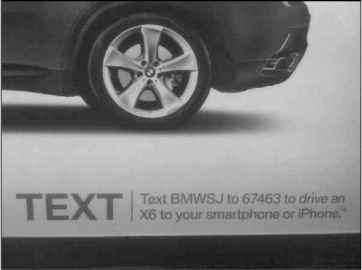Mobile Coupon Delivery
Mobile coupons can be sent using a variety of technologies. The most common method of mobile coupon delivery is through SMS or MMS based on a list of contracts you already have. Mobile coupons can also be delivered via location-based technology, described in more detail later in the chapter. Regardless of the method of delivery, any mobile couponing delivery should be directed through a database or preference center that identifies potential customers and whether they have opted in to mobile communication. This is also discussed later in this chapter.
Coupon Delivery via Text Messaging (SMS)
In 1991, a Finish company called Radiolinja (now known as Elisa) offered the first mobile data service; the first text message was sent in 1993. Text messaging, otherwise known as Short Message Service (SMS), wasn't used much for marketing in North America until after 2000.
SMS messages can be sent from phone to phone or from computer to phone, or they can be sent from a phone to a "common short code," usually abbreviated to simply "short code." See Figure 6.1 and 6.2. A short code is a five- or six-digit phone number that can be dialed as a destination for a text message. Text messages are then sent to a computer communication system instead of a phone. Short codes can be shared or owned privately by a company.
If a short code is shared, certain keywords are set up to trigger the parsing activity of the computer system for the short code. The computer communication system that controls the short code is tasked with sending and parsing all the information for the short code. Shared short codes are easy and cheap to get, but can be risky or complicated depending on the types of text responses you expect to get, and how well the computer system is able to parse them.

- Figure 6.1 Short codes, such as the one shown here, are becoming more common in mobile marketing.

- Figure 6.2 Another example of a short code used in advertising.
Dedicated short codes are ideal, especially for big bands, because they allow you to control the branding and capture all the information that is sent to the short code. The disadvantage is that they can be expensive, and the process to acquire them can be time consuming and cumbersome. Common short codes are generally registered or leased, for a period of time, much like a domain name. The body that controls common short codes in the United States is called the CSC Registry and they have a website at www.USShortcodes.com. Once a short code is leased, you must send applications to each of the carriers in the region that your text messaging campaigns targeted, so that your campaign can be reviewed, provisioned and approved by the carrier. Your application must also pass review from the CTIA Monitoring Agent, who evaluates the campaigns adherence to the Consumer Best Practices.
Initially, SMS was used as a way for carriers to communicate with their subscribers. Later, SMS began to take off as a means of person-to-person communication. It offered a significant cost savings over traditional voice calling and allowed recipients to view and respond to the text message at their discretion. In North America, the first cross-carrier SMS marketing campaign was run by Labatt Brewing Company in 2002. Now, in 2009, it is estimated that more than 74% of mobile subscribers are active users of SMS, and more than 90% of the mobile marketing revenue comes from SMS messaging.
Coupon Delivery via Picture Messaging (MMS)
The late 1990s also saw the development of picture messaging, otherwise known as Multimedia Message Service (MMS). MMS is an extension of the SMS messaging standard but uses the WAP coding language to display multimedia content. Picture messages are sent in much the same way as text messages, but they can contain images, timed slideshows, audio, video, and text. The first group to launch an MMS campaign was a carrier out of Europe called Telenor, in 2002.
Picture message marketing has not been widely adopted in North America, partly because mobile carriers charge for both sending and receiving picture messages. The cost is usually 5 to 10 times higher than it would be for a text message, which creates a substantial disincentive for people to remain opted in to that kind of messaging.
The lack of mass adoption of this type of marketing could also be because no sufficient platform can efficiently send bulk MMS messages. Complications caused by discrepancies in the different networks' MMS messaging standards, and different phone-rendering capabilities make deploying a successful picture messaging campaign time-consuming and difficult.
As with email, concerns arise about unwanted SMS and MMS marketing, otherwise known as spam. This is more prolific in countries where carriers are allowed to sell the phone numbers of their subscribers to third-party advertisers. Many mobile carriers in the United States and Europe now police their own networks, to prevent SMS and MMS SPAM from reaching their subscribers. In December 2005, the Mobile Marketing Association (MMA) outlined Consumer Best Practices Guidelines, which included instructions for SMS marketers. This document is updated twice a year, and is considered the best set of guidelines available in the United States. Be sure to review these guidelines before launching any SMS or MMS marketing campaign. You can find the guidelines here: http://mmaglobal.com/ bestpractices.pdf
Mobile spam is covered in more depth in Chapter 13, "Mobile Marketing Privacy, Spam, and Viruses."
Continue reading here: Mobile Affiliate Marketing
Was this article helpful?

